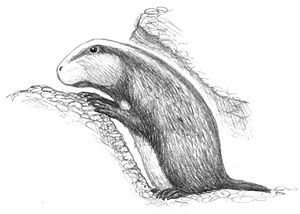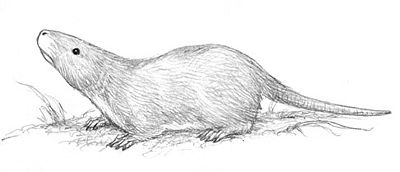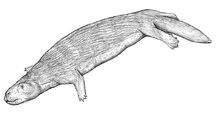In HE, the suborder Gondwanatheria is known only from a few hypsodont teeth (resembling those of e. g. horses, with a very high tooth crown) and one lower jaw from India, Madagascar and South America, and Antarctica. This distribution, matching the outlines of the ancient southern supercontinent, Gondwana, has earned the gondwanatheres their name, and reflects the fact that HE paleontologists knew almost nothing about these mammals aside from their home range. Pretty much all that can be said for sure from the few scattered teeth and single lower jaw bone is that the gondwanatheres were gnawing mammals that ate something hard and abrasive, such as grass. However, since grass had only begun to evolve by the end of the Eocene, at which point all gondwanathere material disappears, this hypothesis hardly sheds any light on these mammals. The species from which the partial jaw comes is thought to have led a rodent-like life in swamps, rather like a modern Spec mangrove beaver, but certainty at this point is impossible.
HISTORY & BIOLOGY[]
Gondwanatheria's position in the mammalian family tree is also enigmatic, and it is easier to say what they were not than what they were. Some paleontologists ally them to xenarthrans or multis, but both possibilities are unlikely. Paleontologists around the world uncorked their champagne bottles, therefore, when it became clear that the gondwanatheres had survived on Spec in some diversity. Now we know that the gondwanatheres belong to the Australosphenida and are therefore the closest living relatives of the famous monotremes. Like most montoremes, gondwanatheres lay sticky eggs, their young lick milk from the mother's fur, and they lack outer ears. Another interesting gondwanathere feature is that they don't have molars behind their four premolars, possibly an adaptation to their hard food and the amount of sand in their diet. Without irreplaceable molars, gondwanatheres have an advantage over other gnawing mammals, able to regrow all the teeth in their mouths as their diet abrades them.
Although these elusive little animals are quite hard to find, gondwanatheres are common and widespread, living everywhere where there are mangroves. In Madagascar, however, they have diversified to take all the niches that xenotheridians and multis have elsewhere. Also worth mention are the two known species of bamboo unrats of Southeast Asia that have finally put hypsodonty to its expected use... or rather beyond that.
Aotearoa Unrat (Progondwanatherium novaezelandiae)[]
Only discovered recently deep within Aotearoa's South Island, the Aotearoa swamp unrat has proven to be a very basal member of the Gondwanatheria. The unrat is also notable for being one of the 3 species of mammals of its home microcontinent. The others, the waitoreke and the kaureke, both monotremes, colonized Aotearoa relatively recently from the ocean, but all signs indicate that the unrat's ancestors lived on the microcontinent since before the breakup of Gondwana.
Unlike other gondwanatheres, the Aotearoa unrat is omnivorous, occasionally eating small crustaceans as well as plants; it also prefers fresh water to salt water. Of course, the oddities don't stop here: unrats grow slowly, lays only one big egg per year, and both sexes retain the poison spurs that are common to all basal mammals, so that even the hungriest gobblers don't dare to dig one up.
Mangrove Beaver (Neogondwanatherium salvatum)[]
The coasts of Brazil and French Guyana are lined with mangroves. Important breeding grounds for many small shark species, this is not where one would expect a semiaquatic mammal. Careful observers will, however, occasionally find silt hills between the roots, covered with twigs and leaf litter and always dry, even during the highest tides. Even more careful observers will find pools dug in the silt and mud, covered with water even during low tides. The pools, up to 30 cm in diameter, are the entrances to complex tunnel systems built by the Brazilian mangrove beaver.
The burrows end in the hills, above the high water line, in remarkably spacious living chambers. There, one or two big eggs are laid once a year. After no less than two months, the young dive out of the tunnel for the first time, and they leave their parents next year, shortly before the next mating season. Mangrove beavers live primarily off fallen twigs and roots. They swim by paddling with their sprawling limbs, especially the big, webbed feet.
Bamboo Unrat (Bambusatherium australe)[]
Despite its abundance, there are not many vertebrates which eat bamboo (p-Bambusoideae), because these giant grasses are simply too tough for most animals to handle. Notable bamboo-eaters are the yando, the false panha and the at least 2 species of bamboo unrats. Although a good swimmer, the pictured southern bamboo unrat does not live near water. It digs its tunnel systems under bamboo forests which it gnaws upon from below.
Common Savanna Unmouse (Enantinesomys fuscus) []
Madagascar has no xenotheridians (except for one or two), no paraselenodonts, and no multis. But at first sight of its diverse gondwanathere fauna, this is not apparent. For example, the common savanna unmouse looks just like any xenotheridian pseudomouse, or, for that matter, a HE mouse, as long as you don't dig up its eggs or manage to have a look at its cheek teeth.
- David Marjanovic, Michael David Hanson, and Daniel Bensen
,=Sudamerica ameghinoi
| ,=Progondwanatherium novaezelandiae (New Zealand Swamp Unrat)
| |
`=| ,=Gondwanatherium patagonicum
| ,=|=Ferugliotherium windhauseni
`=| `=Neogondwanatherium=Neogondwanatherium salvatum (Brazilian mangrove beaver)
|
| ,=Euenanticastor=Euenanticastor chooi (Australian mangrove beaver)
`=|
| ,=Lavanify miolaka
| ,=|
| | | ,=Nesocastor nesocastor (Malagasy mangrove beaver)
| | `=|
| | `=Enantinesomyidae=Enantinesomys=Enantinesomys fuscus (Common savanna unmouse)
`=|
| ,=unnamed from India
| |
`=| ,=Castoridium indicum (Indian mangrove beaver)
| ,=Castorotheriidae=|
| | | ,=Paracastoridium occidentale (West African mangrove beaver)
| | `=|
| | `=Castorotherium africanum (East African mangrove beaver)
`=|
| ,=Exogondwanatherium inexspectatum (Brown mangrove beaver)
`=|
| ,=Bambusatherium=Bambusatherium australe (Southern bamboo unrat)
`=|
`=Sinocastor aureus (Yellow mangrove beaver)






